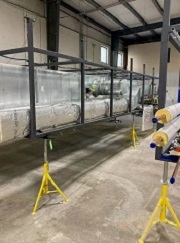New construction projects remain a top priority for growing health systems.
However, as the healthcare industry adjusts to post-pandemic needs, inflationary pressures, and rising labour costs, identifying innovative and effective solutions is more essential than ever.
And, to adapt to today’s healthcare environment needs, new trends are emerging to support the construction process.
When implemented strategically, trending solutions can boost efficiency, lower costs, and promote long-term success.
1. Supply chain resilience
With supply chain disruptions and shortages continuing to impact healthcare teams as they work on new construction projects, leaders need to anticipate delays before they happen.
Reducing reliance on external service contracts can eliminate supplier risk to prepare for future supply chain challenges, shortages, or crises.
Additionally, when health systems establish supplier relationship programmes and assess the performance of critical suppliers, they can develop strong supply chain strategies to support construction and long-term resource sourcing.
2. Prefabrication
Modular mechanical systems have become standard in recent years because prefabricated parts allow health systems to save time and money while executing large-scale projects.
To expedite the construction process, teams opt for modularised furniture, wall systems, and more, which can be purchased, shipped, and installed more efficiently.
Using prefabricated parts also allows health systems to standardise the process and support workers by ensuring a safer and cleaner job site.
Prefabricating segments of a hospital in a controlled warehouse environment means construction can take place, regardless of weather conditions, and workers have more-comfortable working conditions.
3. Innovative solutions
When it comes to innovative technology solutions in healthcare construction and design, only a select few of the new offerings from recent years have proven to be useful and cost effective.
Investing in the right technological advances can have long-term payoffs for the facility in keeping up with a dynamic healthcare environment and meeting the needs of a community over time.
It is important to note, though, that this does not always require investing in expensive new technologies.
Facilities use innovative solutions to meet infectious disease prevention needs, support sustainability initiatives, overcome labour shortages, meet changing compliance standards, and more while carrying out daily operations.
Encouraging creative problem-solving throughout the organisation can help boost efficiency and create substantial impacts.
4. Evidence-based environmental elements
Proven design concepts, including natural light and smooth flooring, support the patient experience and improve health outcomes.
By creating a calm and comfortable environment, evidence-based design principles ensure the right conditions for healing.
Certain elements, such as high air quality and barriers to prevent the spread of infections, also support wellness, while others like neutral colours and sound-absorbing materials promote a calm atmosphere.
 5. Creative renovation spaces
5. Creative renovation spaces
Adaptive reuse in the right setting can be both environmentally friendly and cost effective.
Healthcare teams are increasingly looking at vacant retail and office spaces to renovate and expand into facilities.
Since the start of the pandemic, the inventory of vacant spaces has grown as online shopping and remote work became more popular.
Beginning the construction process with key elements, such as meeting spaces and parking infrastructure, already in place instead of starting from scratch can save time and expense.
However, healthcare electrical and plumbing needs will differ substantially from those of retail and office spaces, so it’s important for teams to choose settings that will be able to adapt to accommodate patient and associate needs.
6. Collaboration with facility management teams
Creating a successful healthcare environment requires a joint effort from healthcare construction and facilities management teams.
Oftentimes, the teams work independently from one another instead of aligning the planning, design, and construction stages with ongoing facilities maintenance.
When health systems tie capital planning, project management, and design together with emergency preparedness, environment of care, and regulatory compliance, facilities are more likely to meet long-term goals, improve service outcomes, and streamline communication.
A unified planning, design, and construction platform supports long-term facility success by aligning building standards and patient care goals.
Sustainability initiatives, for example, can start during facility construction if the healthcare team strategically incorporates environmentally-conscious designs and processes.
Teams should also collaborate on data-based risk assessments in order to build resilient facilities that will be able to serve the community during severe weather events or other emergencies.
Depending on the location of the construction, leaders will need to consider how climate change may impact the facility over time.
As a $40 billion industry, healthcare construction continues to evolve as new strategies develop to cut down costs and ensure more-successful facilities.
And, to keep up with changes, healthcare construction and leadership teams need to consider how to multiply efficiencies, determine best investments, and meet goals in every project.
